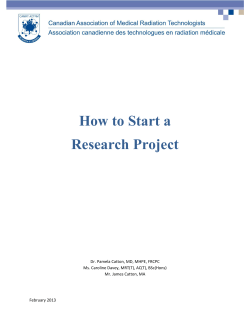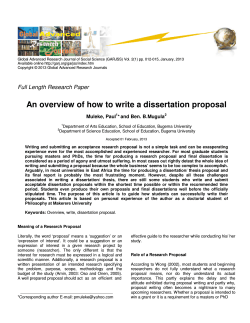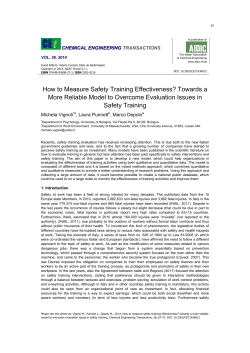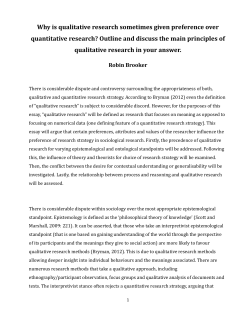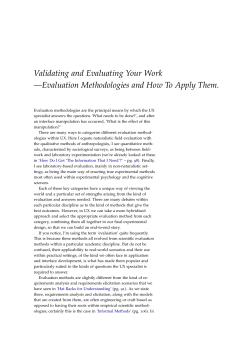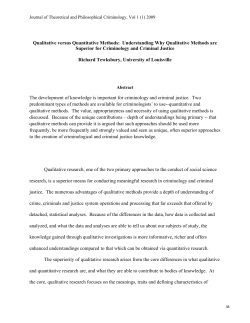
Education and debate
Search Search all BMJ Products Search Search bmj.com BMJ 1997;315:740-743 (20 September) Education and debate How to read a paper: Papers that go beyond numbers (qualitative research) Trisha Greenhalgh, senior lecturer, a Rod Taylor, senior lecturer b a Unit for Evidence-Based Practice and Policy, Department of Primary Care and Population Sciences, University College London Medical School/Royal Free Hospital School of Medicine, Whittington Hospital, London N19 5NF , b Exeter and Devon Research and Development Support Unit, Postgraduate Medical School, Wonford, Exeter EX2 5EQ Correspondence to: Dr Greenhalgh p.greenhalgh@ucl.ac.uk What is qualitative research? Epidemiologist Nick Black has argued that a finding or a result is more likely to be accepted as a fact if it is quantified (expressed in numbers) than if it is not. 1 There is little or no scientific evidence, for example, to support the well known "facts" that one couple in 10 is infertile, or that one man in 10 is homosexual. Yet, observes Black, most of us are happy to accept uncritically such simplified, reductionist, and blatantly incorrect statements so long as they contain at least one number. Top What is qualitative research? Evaluating papers that describe... Conclusion References Researchers who use qualitative methods seek a deeper truth. They aim to "study things in their natural setting, attempting to make sense of, or interpret, phenomena in terms of the meanings people bring to them," 2 and they use "a holistic perspective which preserves the complexities of human behaviour." 1 Summary points Qualitative methods aim to make sense of, or interpret, phenomena in terms of the meanings people bring to them Qualitative research may define preliminary questions which can then be addressed in quantitative studies A good qualitative study will address a clinical problem through a clearly formulated question and using more than one research method (triangulation) Analysis of qualitative data can and should be done using explicit, systematic, and reproducible methods Questions such as "How many parents would consult their general practitioner when their child has a mild temperature?" or "What proportion of smokers have tried to give up?" clearly need answering through quantitative methods. But questions like "Why do parents worry so much about their children's temperature?" and "What stops people giving up smoking?" cannot and should not be answered by leaping in and measuring the first aspect of the problem that we (the outsiders) think might be important. Rather, we need to listen to what people have to say, and we should explore the ideas and concerns which the subjects themselves come up with. After a while, we may notice a pattern emerging, which may prompt us to make our observations in a different way. We may start with one of the methods shown in box box, and go on to use a selection of others. Box 1: Examples of qualitative research methods Documents—Study of documentary accounts of events, such as meetings Passive observation—Systematic watching of behaviour and talk in natural occurring settings Participant observation—Observation in which the researcher also occupies a role or part in the setting, in addition to observing In depth interviews—Face to face conversation with the purpose of exploring issues or topics in detail. Does not use preset questions, but is shaped by a defined set of topics Focus groups—Method of group interview which explicitly includes and uses the group interaction to generate data Box box summarises (indeed, overstates) the differences between the qualitative and quantitative approaches to research. In reality, there is a great deal of overlap between them, the importance of which is increasingly being recognised. 4 Box 2 Qualitative versus quantitative research—the overstated dichotomy Qualitative Quantitative Social theory Action Structure Methods Observation, interview Experiment, survey Question What is X? How many Xs? (classification) (enumeration) Reasoning Inductive Deductive Sampling method Theoretical Statistical Strength Validity Reliability Reproduced with permission from Mays and Pope, Qualitative Research in Health Care 3 Quantitative research should begin with an idea (usually articulated as a hypothesis), which then, through measurement, generates data and, by deduction, allows a conclusion to be drawn. Qualitative research, in contrast, begins with an intention to explore a particular area, collects "data" (observations and interviews), and generates ideas and hypotheses from these data largely through what is known as inductive reasoning. 3 The strength of the quantitative approach lies in its reliability (repeatability)—that is, the same measurements should yield the same results time after time. The strength of qualitative research lies in validity (closeness to the truth)—that is, good qualitative research, using a selection of data collection methods, really should touch the core of what is going on rather than just skimming the surface. The validity of qualitative methods is greatly improved by using a combination of research methods, a process known as triangulation, and by independent analysis of the data by more than one researcher. The so called iterative approach (altering the research methods and the hypothesis as the study progresses, in the light of information gleaned along the way) used by qualitative researchers shows a commendable sensitivity to the richness and variability of the subject matter. Failure to recognise the legitimacy of this approach has, in the past, led critics to accuse qualitative researchers of continually moving their own goalposts. Though these criticisms are often misguided, there is, as Nicky Britten and colleagues have observed, a real danger "that the flexibility [of the iterative approach] will slide into sloppiness as the researcher ceases to be clear about what it is (s)he is investigating." 5 These authors warn that qualitative researchers must, therefore, allow periods away from their fieldwork for reflection, planning, and consultation with colleagues. Evaluating papers that describe qualitative research By its very nature, qualitative research is non-standard, unconfined, and dependent on the subjective experience of both the researcher and the researched. It explores what needs to be explored and cuts its cloth accordingly. It is debatable, therefore, Top What is qualitative research? Evaluating papers that describe... Conclusion what needs to be explored and cuts its cloth accordingly. It is debatable, therefore, Conclusion whether an all-encompassing critical appraisal checklist along the lines of the Users' 6 7 8 9 10 11 12 13 14 15 16 17 18 19 References Guides to the Medical Literature could ever be developed. Our own view, and that of a number of individuals who have attempted, or are currently working on, this very task, 3 5 is that such a checklist may not be as exhaustive or as universally applicable as the various guides for appraising quantitative research, but that it is certainly possible to set some ground rules. The list which follows has been distilled from the published work cited earlier,2 3 5 and also from our own research and teaching experiences. You should note, however, that there is a great deal of disagreement and debate about the appropriate criteria for critical appraisal of qualitative research, and the ones given here are likely to be modified in the future. Question 1: Did the paper describe an important clinical problem addressed via a clearly formulated question? A previous article in this series explained that one of the first things you should look for in any research paper is a statement of why the research was done and what specific question it addressed. 20 Qualitative papers are no exception to this rule: there is absolutely no scientific value in interviewing or observing people just for the sake of it. Papers that cannot define their topic of research more closely than "We decided to interview 20 patients with epilepsy" inspire little confidence that the researchers really knew what they were studying or why. You might be more inclined to read on if the paper stated in its introduction something like, "Epilepsy is a common and potentially disabling condition, and up to 20% of patients do not remain free of fits while taking medication. Antiepileptic medication is known to have unpleasant side effects, and several studies have shown that a high proportion of patients do not take their tablets regularly. We therefore decided to explore patients' beliefs about epilepsy and their perceived reasons for not taking their medication." Question 2: Was a qualitative approach appropriate? If the objective of the research was to explore, interpret, or obtain a deeper understanding of a particular clinical issue, qualitative methods were almost certainly the most appropriate ones to use. If, however, the research aimed to achieve some other goal (such as determining the incidence of a disease or the frequency of an adverse drug reaction, testing a cause and effect hypothesis, or showing that one drug has a better risk-benefit ratio than another), a case-control study, cohort study, or randomised trial may have been better suited to the research question.19 Question 3: How were the setting and the subjects selected? The second box contrasts the statistical sampling methods of quantitative research with theoretical methods of qualitative research. In quantitative research, it is vital to ensure that a truly random sample of subjects is recruited so that the results reflect, on average, the condition of the population from which that sample was drawn. In qualitative research, however, we are not interested in an "on average" view of a patient population. We want to gain an in depth understanding of the experience of particular individuals or groups; we should therefore deliberately seek out individuals or groups who fit the bill. If, for example, we wished to study the experience of non-English speaking British Punjabi women when they gave birth in hospital (with a view to tailoring the interpreting or advocacy service more closely to the needs of this patient group), we would be perfectly justified in going out of our way to find women who had had a range of different birth experiences—an induced delivery, an emergency caesarean section, a delivery by a medical student, a late miscarriage, and so on—rather than a "random" sample of British Punjabi mothers. Question 4: What was the researcher's perspective, and has this been taken into account? PETER BROWN View larger version (131K): [in this window] [in a new window] It is important to recognise that there is no way of abolishing, or fully controlling for, observer bias in qualitative research. This is most obviously the case when participant observation is used, but it is also true for other forms of data collection and of data analysis. If, for example, the research concerns the experience of asthmatic adults living in damp and overcrowded housing and the perceived effect of these surroundings on their health, the data generated by techniques such as focus groups or semistructured interviews are likely to be heavily influenced by what the interviewer believes about this subject and by whether he or she is employed by the hospital chest clinic, the social work department of the local authority, or an environmental pressure group. But since it is inconceivable that the interviews could have been conducted by someone with no views at all and no ideological or cultural perspective, the most that can be required of the researchers is that they describe in detail where they are coming from so that the results can be interpreted accordingly. Question 5: What methods did the researcher use for collecting data—and are these described in enough detail? I once spent two years doing highly quantitative, laboratory based experimental research in which around 15 hours of every week were spent filling or emptying test tubes. There was a standard way to fill the test tubes, a standard way to spin them in the centrifuge, and even a standard way to wash them up. When I finally published my research, some 900 hours of drudgery was summed up in a single sentence: "Patients' serum rhubarb levels were measured according to the method described by Bloggs et al [reference to Bloggs et al's published paper]." The methods section of a qualitative paper often cannot be written in shorthand or dismissed by reference to someone else's research techniques. It may have to be lengthy and discursive since it is telling a unique story without which the results cannot be interpreted. As with the sampling strategy, there are no hard and fast rules about exactly what details should be included in this section of the paper. You should simply ask, "have I been given enough information about the methods used?", and, if you have, use your common sense to assess, "are these methods a sensible and adequate way of addressing the research question?" Question 6: What methods did the researcher use to analyse the data—and what quality control measures were implemented? The data analysis section of a qualitative research paper is where sense can most readily be distinguished from nonsense. Having amassed a thick pile of completed interview transcripts or field notes, the genuine qualitative researcher has hardly begun. It is simply not good enough to flick through the text looking for "interesting quotes" which support a particular theory. The researcher must find a systematic way of analysing his or her data, and, in particular, must seek examples of cases which appear to contradict or challenge the theories derived from the majority. One way of doing this is by content analysis: drawing up a list of coded categories and "cutting and pasting" each segment of transcribed data into one of these categories. This can be done either manually or, if large amounts of data are to be analysed, via a tailor-made computer database. The statements made by all the subjects on a particular topic can then be compared with one another, and more sophisticated comparisons can be made such as "did people who made statement A also tend to make statement B?" In theory, the paper will show evidence of "quality control"—that is, the data (or at least, a sample of them) will have been analysed by more than one researcher to confirm that they are both assigning the same meaning to them, although in practice this is often difficult to achieve. Indeed, when researching this article, we could find no data on the interobserver reliability of any qualitative study to illustrate this point. Question 7: Are the results credible, and if so, are they clinically important? We obviously cannot assess the credibility of qualitative results through the precision and accuracy of measuring devices, nor their significance via confidence intervals and numbers needed to treat. It usually takes little more than plain common sense to determine whether the results are sensible and believable, and whether they matter in practice. One important aspect of the results section to check is whether the authors cite actual data. Claims such as "general practitioners did not usually recognise the value of audit" would be infinitely more credible if one or two verbatim quotes from the interviewees were reproduced to illustrate them. The results should be independently and objectively verifiable—after all, a subject either made a particular statement or (s)he did not—and all quotes and examples should be indexed so that they can be traced back to an identifiable subject and setting. Question 8: What conclusions were drawn, and are they justified by the results? A quantitative research paper should clearly distinguish the study's results (usually a set of numbers) from the interpretation of those results (the discussion). The reader should have no difficulty separating what the researchers found from what they think it means. In qualitative research, however, such a distinction is rarely possible, since the results are by definition an interpretation of the data. It is therefore necessary, when assessing the validity of qualitative research, to ask whether the interpretation placed on the data accords with common sense and is relatively untainted with personal or cultural perspective. This can be a difficult exercise, accords with common sense and is relatively untainted with personal or cultural perspective. This can be a difficult exercise, because the language we use to describe things tends to impugn meanings and motives which the subjects themselves may not share. Compare, for example, the two statements, "three women went to the well to get water" and "three women met at the well and each was carrying a pitcher." It is becoming a cliché that the conclusions of qualitative studies, like those of all research, should be "grounded in evidence"—that is, that they should flow from what the researchers found in the field. Mays and Pope suggest three useful questions for determining whether the conclusions of a qualitative study are valid: how well does this analysis explain why people behave in the way they do? how comprehensible would this explanation be to a thoughtful participant in the setting?; and how well does the explanation cohere with what we already know?3 Question 9: Are the findings of the study transferable to other clinical settings? One of the commonest criticisms of qualitative research is that the findings of any qualitative study pertain only to the limited setting in which they were obtained. In fact, this is not necessarily any truer of qualitative research than of quantitative research. Look back at the example of British Punjabi women described above. You should be able to see that the use of a true theoretical sampling frame greatly increases the transferability of the results over a "convenience" sample. Conclusion Doctors have traditionally placed high value on numerical data, which may in reality be misleading, reductionist, and irrelevant to the real issues. The increasing popularity of qualitative research in the biomedical sciences has arisen largely because quantitative methods provided either no answers or the wrong answers to important questions in both clinical care and service delivery.1 If you still feel that qualitative research is necessarily second rate by virtue of being a "soft" science, you should be aware that you are out of step with the evidence. Top What is qualitative research? Evaluating papers that describe... Conclusion References In 1993, Pope and Britten presented a paper to the BSA Medical Sociology Group conference entitled "Barriers to qualitative methods in the medical mindset," in which they showed their collection of rejection letters from biomedical journals. The letters revealed a striking ignorance of qualitative methodology on the part of reviewers. In other words, the people who had rejected the papers often seemed to be incapable of distinguishing good qualitative research from bad. Somewhat ironically, qualitative papers of poor quality now appear regularly in some medical journals, whose editors have climbed on the qualitative bandwagon without gaining an ability to appraise such papers. Note, however, that the critical appraisal of qualitative research is a relatively underdeveloped science, and the questions posed in this chapter are still being refined. The articles in this series are excerpts from How to read a paper: the basics of evidence based medicine. The book includes chapters on searching the literature and implementing evidence based findings. It can be ordered from the BMJ Publishing Group: tel 0171 383 6185/6245; fax 0171 383 6662. Price £13.95 UK members, £14.95 non-members. Acknowledgements Thanks to Professor Nick Black for advice on this article. References 1. Black N. Why we need qualitative research. J Epidemiol Community Health 1994;48:425-6. [Medline] 2. Denkin NK, Lincoln YS, eds. Handbook of qualitative research. London: Sage, 1994. Top What is qualitative research? Evaluating papers that describe... Conclusion References References 3. Mays N, Pope C, eds. Qualitative research in health care. London: BMJ Publishing Group, 1996. 4. Abell P. Methodological achievements in sociology over the past few decades with specific reference to the interplay of qualitative and quantitative methods. In: Bryant C, Becker H, eds. What has sociology achieved? London: Macmillan, 1990. 5. Britten N, Jones R, Murphy E, Stacy R. Qualitative research methods in general practice and primary care. Fam Pract 1995;12:104-14. 6. Oxman AD, Sackett DL, Guyatt GH. Users' guides to the medical literature. I. How to get started. JAMA 1993;270:2093-5. 7. Guyatt GH, Sackett DL, Cook DJ. Users' guides to the medical literature. II. How to use an article about therapy or prevention. A. Are the results of the study valid? JAMA 1993;270:2598-601. 8. Guyatt GH, Sackett DL, Cook DJ. Users' guides to the medical literature. II. How to use an article about therapy or prevention. B. What were the results and will they help me in caring for my patients? JAMA 1994;271:59-63. [Free Full Text] 9. Jaeschke R. Guyatt G. Sackett DL. Users' guides to the medical literature. III. How to use an article about a diagnostic test. A. Are the results of the study valid? JAMA 1994;271:389-91. [Medline] 10. Jaeschke R. Guyatt G. Sackett DL. Users' guides to the medical literature. III. How to use an article about a diagnostic test. B. What were the results and will they help me in caring for my patients? JAMA 1994;271:703-7. [Medline] 11. Levine M, Walter S, Lee H, Haines T, Holbrook A, Moyer V. Users' guides to the medical literature. IV. How to use an article about harm. JAMA 1994;271:1615-9. [Medline] 12. Laupacis A. Wells G. Richardson WS. Tugwell P. Users' guides to the medical literature. V. How to use an article about prognosis. JAMA 1994;271:234-7. [Abstract] 13. Oxman AD, Cook DJ, Guyatt GH. Users' guides to the medical literature. VI. How to use an overview. JAMA 1994;272:1367-71. [Medline] 14. Richardson WS, Detsky AS. Users' guides to the medical literature. VII. How to use a clinical decision analysis. A. Are the results of the study valid? JAMA 1995;273:1292-5. [Medline] 15. Richardson WS, Detsky AS. Users' guides to the medical literature. VII. How to use a clinical decision analysis. B. What are the results and will they help me in caring for my patients? JAMA 1995;273:1610-3. 16. Hayward RSA, Wilson MC, Tunis SR, Bass EB, Guyatt G. Users' guides to the medical literature. VIII. How to use clinical practice guidelines. A. Are the recommendations valid? JAMA 1995;274:570-4. 17. Wilson MC, Hayward RS, Tunis SR, Bass EB, Guyatt G. Users' guides to the medical literature. VIII. How to use clinical practice guidelines. B. Will the recommendations help me in caring for my patients? JAMA 1995;274:1630-2. [Medline] 18. Drummond MF, Richardson WS, O'Brien BJ, Levine M, Heyland D. Users' guides to the medical literature XIII. How to use an article on economic analysis of clinical practice. A. Are the results of the study valid? JAMA 1997;277:1552-7. [Medline] 19. O'Brien BJ, Heyland D, Richardson WS, Levine M, Drummond MF. Users' guides to the medical literature XIII. How to use an article on economic analysis of clinical practice. B. What are the results and will they help me in caring for my patients? JAMA 1997;277:1802-6. [Medline] 20. Greenhalgh T. Getting your bearings (deciding what the paper is about). BMJ 1997;315:243-6. [Free Full Text] 21. Kinmonth A-L. Understanding and meaning in research and practice. Fam Pract 1995;12:1-2. This article has been cited by other articles: Mwanga, J. R., Jensen, B. B., Magnussen, P., Aagaard-Hansen, J. (2008). School children as health change agents in Magu, Tanzania: a feasibility study. HEALTH PROMOT INT 23: 16-23 [Abstract] [Full text] Protheroe, J., Bower, P., Chew-Graham, C. (2007). The use of mixed methodology in evaluating complex interventions: identifying patient factors that moderate the effects of a decision aid. Fam Pract 24: 594600 [Abstract] [Full text] Smith, A. F. (2007). Reaching the parts that are hard to reach: expanding the scope of professional education in anaesthesia. Br J Anaesth 99: 453-456 [Full text] education in anaesthesia. Br J Anaesth 99: 453-456 [Full text] Amiel, P., Moreau, D., Vincent-Genod, C., Alberti, C., Hankard, R., Ravaud, P., Gottot, S., Gaultier, C. (2007). Noninvitation of Eligible Individuals to Participate in Pediatric Studies: A Qualitative Study. Arch Pediatr Adolesc Med 161: 446-450 [Abstract] [Full text] McGrath, P., Holewa, H., Kail-Buckley, S. (2007). "They Should Come Out Here ...": Research Findings on Lack of Local Palliative Care Services for Australian Aboriginal People. AM J HOSP PALLIAT CARE 24: 105-113 [Abstract] Taylor, B. J., Dempster, M., Donnelly, M. (2007). Grading Gems: Appraising the Quality of Research for Social Work and Social Care. Br J Soc Work 37: 335-354 [Abstract] [Full text] Meyrick, J. (2006). What is Good Qualitative Research?: A First Step towards a Comprehensive Approach to Judging Rigour/Quality.. J Health Psychol 11: 799-808 [Abstract] Hayes, R. P., Bowman, L., Monahan, P. O., Marrero, D. G., McHorney, C. A. (2006). Understanding diabetes medications from the perspective of patients with type 2 diabetes: prerequisite to medication concordance.. The Diabetes Educator 32: 404-414 [Abstract] [Full text] Benin, A. L., Wisler-Scher, D. J., Colson, E., Shapiro, E. D., Holmboe, E. S. (2006). Qualitative Analysis of Mothers' Decision-Making About Vaccines for Infants: The Importance of Trust. Pediatrics 117: 15321541 [Abstract] [Full text] Macdonald, M. E., Liben, S., Carnevale, F. A., Rennick, J. E., Wolf, S. L., Meloche, D., Cohen, S. R. (2005). Parental Perspectives on Hospital Staff Members' Acts of Kindness and Commemoration After a Child's Death. Pediatrics 116: 884-890 [Abstract] [Full text] Treloar, C., Graham, I. D. (2003). Multidisciplinary Cross-National Studies: A Commentary on Issues of Collaboration, Methodology, Analysis, and Publication. Qual Health Res 13: 924-932 [Abstract] Evans, R., Stone, D., Elwyn, G. (2003). Organizing palliative care for rural populations: a systematic review of the evidence. Fam Pract 20: 304-310 [Abstract] [Full text] Walters, K., Buszewicz, M., Russell, J., Humphrey, C. (2003). Teaching as therapy: cross sectional and qualitative evaluation of patients' experiences of undergraduate psychiatry teaching in the community. BMJ 326: 740-740 [Abstract] [Full text] Gonzalez, L. S III (2003). Referees make journal clubs fun. BMJ 326: 106-106 [Full text] McGrath, P. (2003). Spiritual pain: A comparison of findings from survivors and hospice patients. AM J HOSP PALLIAT CARE 20: 23-33 [Abstract] Whelan, A., Wrigley, N., Warm, D., Cannings, E. (2002). Life in a 'Food Desert'. Urban Stud 39: 20832100 [Abstract] Rychetnik, L, Frommer, M, Hawe, P, Shiell, A (2002). Criteria for evaluating evidence on public health interventions. J. Epidemiol. Community Health 56: 119-127 [Abstract] [Full text] von Faber, M., Bootsma-van der Wiel, A., van Exel, E., Gussekloo, J., Lagaay, A. M., van Dongen, E., Knook, D. L., van der Geest, S., Westendorp, R. G. J. (2001). Successful Aging in the Oldest Old: Who Can Be Characterized as Successfully Aged?. Arch Intern Med 161: 2694-2700 [Abstract] [Full text] Cook, D. J., Meade, M. O., Perry, A. G. (2001). Qualitative Studies on the Patient's Experience of Weaning From Mechanical Ventilation. Chest 120: 469S-473S [Abstract] [Full text] Cranney, M., Warren, E., Barton, S., Gardner, K., Walley, T. (2001). Why do GPs not implement evidence-based guidelines? A descriptive study. Fam Pract 18: 359-363 [Abstract] [Full text] evidence-based guidelines? A descriptive study. Fam Pract 18: 359-363 [Abstract] [Full text] Hahn, H., Pool Hegamin, A. (2001). Assessing Scientific Measures of Disability. Journal of Disability Policy Studies 12: 114-121 [Abstract] Walker, S., McGeer, A., Simor, A. E., Armstrong-Evans, M., Loeb, M. (2000). Why are antibiotics prescribed for asymptomatic bacteriuria in institutionalized elderly people?: A qualitative study of physicians' and nurses' perceptions. CMAJ 163: 273-277 [Abstract] [Full text] Lloyd, G., Skarratts, D., Robinson, N., Reid, C. (2000). Communication skills training for emergency department senior house officers--a qualitative study. Emerg. Med. J. 17: 246-250 [Abstract] [Full text] Contact us - Privacy policy - Web site terms & conditions - Site map HighWire Press - Feedback - Help - © 1997 BMJ Publishing Group Ltd.
© Copyright 2025

